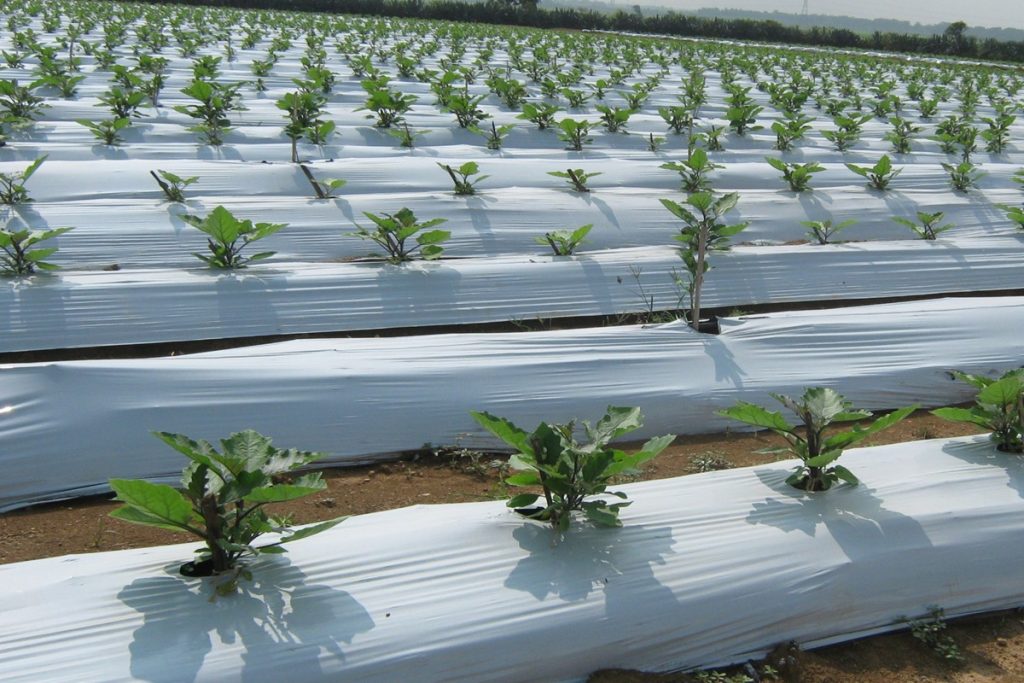In modern agricultural systems, black and white polyethylene (PE) films serve as versatile ground cover materials, leveraging their unique optical and physical properties to enhance crop yield and quality. TRADSARK, with global agricultural insights, delves into the core functions, synergistic applications, and sustainable value of these films.
I. Core Function Comparison of Black and White PE Films
Black Mulch Film: The Soil Microclimate Regulator
- Temperature Enhancement for Early Growth
- Absorbs over 90% of solar radiation, raising soil temperature by 3–5°C (most effective in spring), shortening germination cycles. Ideal for early-maturing solanaceous crops (e.g., tomatoes, peppers).
- Data: In Shouguang, Shandong, tomato planting with black mulch reduces time from transplanting to maturity by 10–15 days, increasing early yields by 20%.
- Weed Suppression
- Blocks ≥95% sunlight, inhibiting weed photosynthesis and reducing weed emergence by 90%. Cuts herbicide use and labor costs (saves 300–500 CNY/acre annually).
- Moisture Retention and Soil Protection
- Reduces soil water evaporation by 40–60%, extending irrigation cycles by 3–5 days in arid regions. Mitigates soil erosion (reduces runoff by 70%).
White Mulch Film: The Light Utilization Optimizer
- Reflective Cooling and Stress Reduction
- Reflects 70–85% of sunlight, lowering soil temperature by 2–4°C in high summer, alleviating heat stress for cool-season crops like lettuce and strawberries.
- Application: A Yunnan strawberry farm using white mulch in summer reduced fruit deformity rates from 18% to 8%, improving marketable fruit by 15%.
- Spectral Pest Management
- Reflects UV-B radiation to suppress pests like aphids and whiteflies. Combined with silver mulch (a black-white variant), pest repellency increases by 50%.
- Dual-Layer Synergy
- Black-white composite films (black side down for weed control, white side up for reflection) enhance coloration in high-value crops (e.g., cherries, pepino).
II. Synergistic Application Scenarios
1. Vegetable Cultivation: All-Season Solutions
- Spring Early Maturity: Black mulch for cucumbers and watermelons warms soil, advancing harvest by 7–10 days with 15–20% yield increase.
- Summer Stress Resistance: White mulch for spinach and celery maintains soil at 20–25°C, preventing bolting and improving marketability by 30%.
- Year-Round Cultivation: Black-white films for extended tomato growing seasons: initial black-side weed control, later flipped to white-side for color enhancement, boosting full-red fruit rate by 25%.
2. Fruit Trees and Cash Crops: Quality Enhancement
- Strawberry Fruit Expansion: White mulch promotes uniform coloration and increases sugar content (Brix +1–1.5°), while reducing gray mold incidence by 40%.
- Grape Veraison: Black mulch controls weeds, while white/silver mulch accelerates anthocyanin synthesis, achieving 80% full-red fruit in Red Globe grapes (vs. 50% without).
- Medicinal Plants: Black mulch for shade-tolerant crops like ginseng and notoginseng suppresses weeds and maintains soil moisture (±2% humidity fluctuation), enhancing active ingredient content by 10–15%.
3. Special Environment Adaptation
- Saline-Alkali Soil Remediation: Black mulch reduces evaporation and salt accumulation (surface salinity ↓30–50%), accelerating desalination with leaching.
- Greenhouse Vertical Farming: White mulch beneath shelves reflects LED light to lower tiers, improving leafy green light uniformity from 65% to 90% and increasing yield by 40%.
III. TRADSARK’s Technological Breakthroughs
1. Material Innovation: Durability Meets Sustainability
- Multi-Layer Co-Extrusion:
- White Surface: Nano-titanium dioxide particles boost reflectivity to 85%, with UV resistance (retains ≥90% strength after 500-hour UV testing).
- Black Base: Carbon black masterbatch and antioxidants ensure 5+ years of weather resistance, with tensile strength ≥25MPa for mechanical laying.
- Biodegradable Options: Bio-based PE mulch (30% plant-derived resin) degrades naturally within 1–2 years, leaving ≤5% residue, compliant with EU EN 17033.
2. Functional Design: Precision for Crop Needs
- Thickness Customization:
- 0.01–0.02mm Ultra-Thin: Cost-effective for short-season crops (e.g., leafy greens), 20% lighter with easier recycling.
- 0.05–0.1mm Reinforced: Puncture-resistant (≥50N) for mechanized operations and perennial crops.
- Composite Structures: Black-white dual films (matte black + glossy white) optimize reflectivity and weed control for high-humidity greenhouse environments (water vapor transmission ≤1g/m²·day).
IV. Sustainable Agriculture Practices: From Mulch to Circular Economy
1. Plastic Reduction and Recycling
- Lightweight Design: 10–15% thinner films reduce material use from 8kg to 6–7kg/acre, saving thousands of tons of plastic annually.
- Closed-Loop Recycling: Partnerships with cooperatives offer “mulch-for-agricultural-inputs” programs, achieving >70% recycling rates. Recycled films are repurposed into non-food packaging, closing the material loop.
2. Low-Carbon Production
- Solar-powered casting lines reduce energy consumption by 35%, with carbon intensity ≤2.5kg CO₂/kg mulch.
- Water-soluble mulch (scheduled for 2025 launch) dissolves into water and CO₂ post-planting, eliminating manual recycling for no-till farming.
V. Selection and Usage Guidelines
1. Scenario-Based Product Matching
| Application | Film Type | Thickness (mm) | Width (m) | Key Functions |
|---|---|---|---|---|
| Spring Open-Field Veggies | Black Mulch | 0.015–0.02 | 2–4 | Warmth, weed control, moisture retention |
| Summer Greenhouse Seedlings | White Mulch | 0.01–0.012 | 1–2 | Cooling, light reflection, pest inhibition |
| Orchard Year-Round Cover | Black-White Dual | 0.03–0.05 | 3–6 | Weed control, light reflection, durability |
| Saline-Alkali Remediation | Reinforced Black | 0.05 | 4–8 | Salt inhibition, soil stabilization |
2. Best Practices
- Laying Timing:
- Open-field: After soil temp stabilizes above 10°C, avoiding strong winds (>4 Beaufort).
- Greenhouse: 5–7 days before transplanting, with drip tape positioned 10–15cm from plant bases.
- Environmental Care:
- Recycle trimmings immediately; never burn (releases dioxins).
- Replace films with >10% damage to prevent microplastic pollution.
VI. Future Trends: Smart Mulch Innovation
TRADSARK is developing “smart mulch” integrated with sensors to monitor real-time soil temperature, humidity, and light. Linked to irrigation and fertilization systems, this technology (scheduled for 2026) aims to reduce chemical use by 20%, transforming traditional mulch into smart agricultural infrastructure.
Conclusion: Redefining Agricultural Productivity in Black and White
Black and white PE films create a microecological balance of light, heat, water, and soil, driving efficiency and sustainability. TRADSARK’s material innovations and full-cycle solutions empower farmers globally to enhance yields while protecting soil health and reducing carbon footprints.
Choose TRADSARK Black & White PE Films to turn every acre into a symbiosis of productivity and environmental stewardship.
TRADSARK—Engineering the Future of Agricultural Coverings


